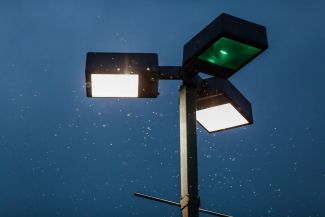Blinded by the Light: How to Avoid Excessive Night Light Pollution
- March 28, 2024
- Best Practices
- Lighting

Are you afraid of the dark? Well, what if I told you that more darkness can actually have positive effects on our world? Excessive artificial light, also known as night light pollution, has been shown to disrupt the balance of darkness essential for human health, wildlife and the environment. Many environmentalists, naturalists, and medical researchers consider light pollution to be one of the fastest growing and most pervasive forms of environmental pollution. What can you do to help? Learn why going to the dark side isn’t such a bad thing and how you can avoid excessive light pollution.
WHAT CAUSES NIGHT LIGHT POLLUTION?
Night light pollution happens when humans excessively and artificially alter outdoor light levels, and there are four main types of light pollution:
- Glare – excessive brightness
- Sky Glow – when the sky is brightened over cities
- Light Trespass – light in areas where it is not intended or needed
- Clutter – bright, confusing and excessive groups of lighting
It has been estimated that 83 percent of the world's people live under light-polluted skies and that 23 percent of the world's land area is affected by skyglow. Night light pollution may come from security lights, streetlights, electronic billboards, parking lots, sporting events, factories and housing. The primary cause of night light pollution is outdoor lights that emit light upwards or sideways.
HOW DOES NIGHT LIGHT POLLUTION AFFECT HUMANS AND ANIMALS?
Night light pollution can contribute to circadian rhythm disorders in both humans and animals. When this happens, your body’s internal clock (which tells you when it’s time to sleep or wake), is out of sync with your environment. For humans, this can cause psychological effects on well-being, including increased stress and difficulties at school or work. Studies have shown that exposure to artificial light at night increases risk for sleep disorders, depression, obesity, diabetes, heart disease, cancer and more.
For animals, night light pollution can cause disorientation that leads to altered behaviors, sleep patterns and reproductive cycles. For example, we see a disruption with the reproduction cycle of turtles. Normally, a full moon will trigger turtles to come back to shore and lay eggs, but artificial lighting can trick turtles into thinking it’s a full moon, causing them to lay eggs earlier than they’re supposed to. Artificial lights can also cause birds to wander off course, interfere with the way predators hunt at night and contribute to the decline of insect populations.
HOW CAN WE MINIMIZE NIGHT LIGHT POLLUTION?
The Florida Fish and Wildlife Conservation Commission has developed a Wildlife Lighting Criteria that provides property and business owners guidelines to minimize lighting impacts to the environment. Other cities in the U.S. have adopted similar dark sky compliance legislation that has been helpful in reducing night light pollution.
In addition, many manufacturers have products that help to increase the dark sky at night. One popular method is developing lights that illuminate down towards the ground, instead of shooting the light up into the sky. Other products reduce glare and avoid over-lighting.
LED lighting also provides very precise optical control to reduce light trespass. Let’s say you have a property line with a residential neighborhood next to a commercial property. With LED lighting, within 12 inches of that property line, we can reduce the number of foot-candles to 0. This precise lighting control results in a nighttime environment that is more pleasant and saves energy.
WHAT ELSE SHOULD YOU CONSIDER WHEN UPGRADING TO OUTDOOR LED LIGHTING?
Upgrading from traditional lighting systems to customized LED lighting and controls represents a significant step towards reducing night light pollution. Although many contractors are concerned with matching wattage when replacing legacy fixtures, lighting designers can often provide a solution that improves the lighting with fewer fixtures – which can also mean a lower installation cost. With today’s LED lighting, you don’t have to replace watt for watt. Delivered lumens on task – what's actually hitting the ground illuminating at night – is the focus. This means customers can save money on the products while getting equal to or better lighting for their location.
The improved LED technology also lets lighting designers put controls in place that allow adjustments to lighting at certain times or occupancy levels. For example, several hospitals have adopted this technology in their parking lots. They'll keep areas at full illumination where activity is taking place around-the-clock, but after a certain time, all the patient or visitor parking areas will dim down or be put on motion sensors. This was previously impossible to control with metal-halide or high-pressure sodium lights. It’s a very nominal cost to add controls to your exterior lighting - it’s usually paid for within the first month with the electricity cost savings.
GET THE RIGHT LIGHTING SOLUTION FOR YOUR PROJECT.
Working on an outdoor lighting project and trying to find the sweet spot between too dim and too bright? Contact a Van Meter lighting specialist to discuss your project and determine the most efficient layout.

ARTICLE BY:
CHARLES DIX
EMPLOYEE-OWNER, LIGHTING SPECIALIST